
The original text is from Crypto Leaks, an investigation company that exposes scandals in the cryptocurrency industry. The first two cases they exposed were about ICP being manipulated by capital to drive down prices and malicious short selling. In the section about SBF, Crypto Leaks investigated the market doubts and conditions at the time and believed that the ICP token was clearly manipulated before and after listing. As the "spokesperson" for Solana, which was extremely popular in 2021, SBF had the motivation and ability to destroy its biggest competitor, the IC network (however, there is no substantial evidence, and there won't be in the future).
This article is about Arkham and provides a large amount of video evidence showing that Arkham received sponsorship and deliberately published a research report to smear ICP. The DFINITY Foundation later cited this article in a defamation lawsuit against Arkham and The New York Times. The article was published on June 9, 2022, with some modifications by the translator.
Summary of this article:
• Use spy dialogue videos and facts to examine the ICP report released by Arkham Intelligence in June 2021.
• The report is about the IC network launched by the DFINITY Foundation, with its native token named ICP.
• At that time, Arkham was just a newcomer with no records or obvious professional knowledge related to cryptocurrency research.
• Their only publicly known team member is founder Miguel Morel—aside from his LinkedIn page claiming he is a cryptocurrency investor and helped create a cryptocurrency business called Reserve, we couldn't find any information about him.
• The Arkham ICP report claims that when the DFINITY Foundation launched the IC network, insiders engaged in "pumping and dumping," which is the reason for the fluctuation in ICP prices. However, they did not provide any substantial evidence.
• The report was published on Twitter and accompanied by a video made in the style of a crime documentary.
• Because of its biased content and lack of substance, the report should not have received any coverage, but it mysteriously became associated with The New York Times. The New York Times turned the report into a "lethal weapon" against the reputation of DFINITY.
• Arkham's founder Miguel claimed that the report was not paid for.
• However, the spy videos we collected show that Arkham was commissioned to produce a "defamatory" report against the ICP token, and the commissioning party may be a competitor of the IC network.
• The Arkham ICP report and The New York Times article were subsequently used as the basis for attacking the DFINITY Foundation.
• After the report was published, the Arkham team moved to a luxury mansion in Chelsea, London, apparently obtaining a large amount of funding from somewhere. The video shows a security team guarding unidentified goods entering the mansion.
Investigation Background
The Internet Computer (IC) blockchain went live on May 10, 2021, developed by a large team from the DFINITY Foundation. Before the official launch of IC, people were very excited because IC was claimed to be able to play the role of the "world computer," providing a decentralized alternative to traditional IT and supporting fully on-chain Web3 services, such as social networks.
After the mainnet launch, its native token ICP could be transferred on the network, and cryptocurrency exchanges around the world began creating spot markets where users could trade ICP tokens. At the beginning of the mainnet launch and in the following hours, the price of the ICP token remained above $450, with a fully diluted market value of over $230 billion, which was an undisputed overvaluation. Then, the price started to decline.
As of June 28, 2021, the price of ICP had dropped to $50, with a fully diluted market value of $23.5 billion, which can be considered comparable to other competing networks at the time.
Subsequently, a previously unknown research company, Arkham Intelligence, led by its unknown founder and CEO Miguel Morel, released the "Arkham ICP Report."
The basic claim of the Arkham ICP report is that the DFINITY Foundation, as the main contributor to the underlying technology of the IC network, along with related insiders, somehow set a high initial price for the ICP token and engaged in "pumping and dumping" when the token was listed.
However, for an organization composed of hundreds of renowned computer science researchers, cryptographers, and engineers, spending years developing a blockchain network and then abandoning its vision at the launch of the mainnet is highly unusual. Furthermore, the report is full of unverified claims, inaccuracies, and obvious logical fallacies. To any experienced observer in the cryptocurrency field, this looks very much like market manipulation aimed at damaging the reputation of DFINITY, possibly sponsored by a competitor of the IC network or financial participants hoping to short its token.
The Arkham ICP report would not have received much attention, but thanks to The New York Times columnist Andrew Ross Sorkin, the report was publicized by The New York Times in an article and a Dealbook newsletter at the same time. Both articles promoted the report. By providing credibility to the report, The New York Times caused significant damage to the reputation of the DFINITY Foundation and its leaders, as well as the IC ecosystem. It can be said that this led to a devaluation of the ICP token by hundreds of billions of dollars. It is not clear why The New York Times chose to promote the "Arkham ICP Report," as it is clearly not a credible source of information.
From all perspectives, the DFINITY Foundation did not sell any ICP tokens in the weeks following the mainnet launch. The project's founder, Dom, stated that he only sold a small portion of the tokens (only 5% of his holdings). In addition, common sense tells us that if the market price of the ICP token is too high after the mainnet launch, it would naturally decline through normal price discovery, without the need for "internal dumping."

In this article, we explore the individuals and content behind the Arkham ICP report, as well as the puzzling decision by The New York Times to promote the report. As we have shown through spy videos and other means, the actions of The New York Times become increasingly perplexing as the investigation deepens.
Why Did The New York Times Support the Arkham ICP Report?
The New York Times published an article titled "Dramatic Collapse of Cryptocurrencies is Shocking," and at the same time, they published "How ICP's Proud 1C0 Collapsed" in the Dealbook newsletter, which was also sent to subscribers. (Note: After this article was published, the DFINITY Foundation filed a defamation lawsuit against The New York Times and Arkham Intelligence. The New York Times subsequently edited the title, removing the word "1C0")
In "How ICP's Proud 1C0 Collapsed," The New York Times referred to Arkham Intelligence as a credible "cryptocurrency analysis company" and promoted the Arkham ICP report, providing a link to the report. Meanwhile, although Arkham had not published any content before, more than a year later (as of June 2022), they had not published any other content.
In "How ICP's Proud 1C0 Collapsed," The New York Times repeatedly and erroneously referred to the IC network, which was undergoing the mainnet launch, as "initial coin offering," or "1C0" (involving an organization selling unusable tokens to the public to raise development funds, with the promise that this would make the tokens usable)—something that has long been prohibited by regulatory agencies in many countries—clearly to deliberately smear the DFINITY Foundation as engaging in illegal activities.
The basic theme of the article can be summarized by a statement made by Miguel Morel in a short video promoting the Arkham ICP report on Twitter. The video uses the background music commonly used in crime exposés in TV shows, expressing his claim—that DFINITY Foundation and insiders are "guilty":
"Our findings lead us to believe that insiders at DFINITY have been depositing and dumping billions of dollars' worth of ICP tokens on exchanges, while others watch their investments shrink. If the available data in our analysis is accurate, we should propose that the ICP token may be one of the most extreme cases of investor abuse in the history of the cryptocurrency market and the entire financial market."

Miguel made explicit accusations against the DFINITY Foundation and insiders. Although Arkham Intelligence had only 200 followers on Twitter at the time of the publication, thanks to the promotion by The New York Times, by May 2022, the video from Arkham Intelligence had been viewed nearly 20,000 times, and their "views" had become famous.
As we described in the section about SBF, the Arkham ICP report was likely created for a specific purpose to harm ICP, whether by a competitor or market manipulators hoping to short ICP. So, why did The New York Times, with its distinguished history and mission to seek the truth on behalf of its readers, provide credibility and due reputation to Arkham?
Something started to go wrong from the moment our investigators began collecting spy videos and understanding what was happening…
Investigating Arkham Intelligence
The naming of Arkham Intelligence seems to pay homage to Gotham Research, a well-known and respected financial research company. However, we do not believe that The New York Times confused the two when deciding to promote Arkham as a credible "cryptocurrency analysis company." Arkham Intelligence has no previous records and has only one publicly known employee, Miguel Morel, who also has no previous records.
Only two points of investigation have already raised serious red flags, and we have discovered even more serious issues.
Where is the Arkham Team?
They are registered in Delaware, USA, and were established on March 4, 2021.

However, this establishment date does not match their Twitter account, which was created in May 2019, two years earlier, indicating that the account was renamed. Their first tweet appeared on June 28, 2021, the same day as The New York Times published their article. This date also does not match Miguel Morel's LinkedIn profile, which states that he joined Arkham in January 2020. But these inconsistencies with dates are just the beginning.
However, in the short period after the publication of the ICP report, the Arkham team was still working at their headquarters in the countryside outside Austin, Texas, rather than the luxurious office you would expect from a respected research company:

But after the ICP report gained attention, this small team of a few people moved out of Texas. Perhaps they made a lot of money because they moved to a luxury mansion in Chelsea, London. According to the initial advertisement, the rent for this mansion is £32,500, or $43,000 per month.

Some may think that "cryptocurrency analysis" might be a simple business, but Arkham is registered across the United States: Delaware, California, New York, and even Colorado.
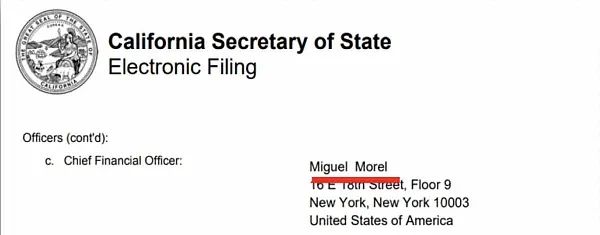
Arkham in Chelsea
Arkham's new headquarters in Chelsea, London, accommodates many Arkham team members or branches. Some new members include: Henry Fisher, the head of the cryptocurrency project Reserve and current CTO of Arkham; Charlie Smith, former business development director at Reserve and co-founder of Arkham; Jonah Bennet, a journalist and co-founder of an online magazine that employs several Arkham employees as writers; Zachary Lerangis, current COO of Arkham; Keegan McNamara, former TPM of Arkham.
Three things are worth noting.
First, these people are all in their early twenties.
Second, Charlie Smith and Keegan McNamara have now left Arkham and are starting a new startup, reflecting the turnover of Arkham members and why it should not be seen as a traditional company.
Third, three members have connections to a "stablecoin" project called Reserve, and Miguel also claims to be a co-founder of the project…
What is the Reserve Project?
Reserve is not a large-scale tech project like the IC network. Its goal is to provide a "stablecoin" running on the Ethereum network. Investors can buy stablecoins through its RSR token, which has dropped in value by over 96.5% since its peak.
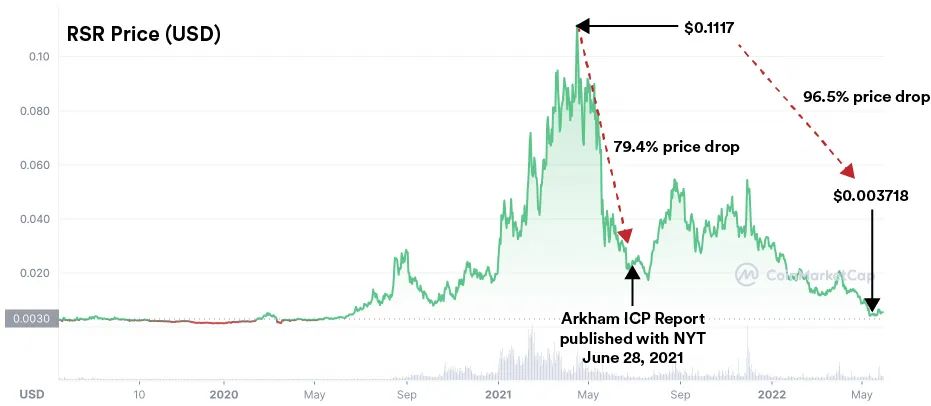
Cryptocurrency enthusiasts would hope to see reports written by thoroughly researched, impartial, and objective professional researchers, rather than by cryptocurrency entrepreneurs, which could lead to biased and inaccurate conclusions. Particularly perplexing is that their own token, RSR, experienced a sharp decline at the same time as the ICP token, but they probably would not claim that the price drop was due to insider trading.
Due to the sharp drop in the price of Bitcoin, the prices of many tokens also plummeted, a decline that began almost from the moment the IC mainnet went live. From April 14, 2021, to July 20, 2021, BTC dropped from $63,314 to $29,807. The largest drop occurred on May 10, 2021, the same day as the IC mainnet launch. However, the Arkham report completely ignored the impact of BTC on the price of ICP, even though it also caused their own RSR token to drop by 79.4%.
Even if they had direct experience of how market fluctuations at the time affected token prices, when Arkham created the ICP report, they mysteriously did not mention these market trends and instead chose to weave a false narrative about improper behavior by insiders at DFINITY, proving that their actions were intentional.
Information about Miguel Morel
At the time of the release of the ICP report, founder and CEO Miguel Morel was the only publicly known Arkham employee. His LinkedIn profile revealed very little career history and qualifications. Given that the emblem of a university has been added to his resume, he seems to have graduated from high school and attended university courses. Miguel claims to be a co-founder of Reserve, but shortly after the publication of the Arkham ICP report, Reserve removed all information about Miguel from their official website.
Although Reserve did not list Miguel as a co-founder when Arkham published the ICP report, their website did contain a blog post attributed to Miguel Morel, which was quickly deleted.
While it is not clear what it means for Miguel Morel to claim to be a "co-founder" of Reserve, this affiliation reflects that he may have pre-existing financial interests in cryptocurrency, which could make his claims far from fair and objective.
Clearly, in promoting a report that could cause billions of dollars in losses and endorsing it, this is not something The New York Times should be able to trust from a normal person.
Was Arkham's ICP Report Sponsored?
The New York Times published their article and DealBook newsletter promoting the Arkham ICP report on June 28, 2021. A few days later, as the IC ecosystem and ICP token were damaged, Miguel Morel posted his last tweet (at the time of writing), claiming that he was not sponsored to write the report, did not receive any form of compensation, and did not hold or short ICP:
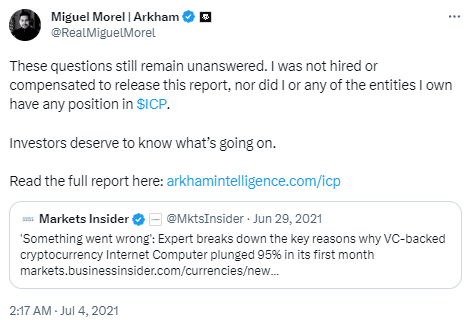
However, in a spy video we collected, Arkham employee Nick Longo stated that he believed the client had already paid for the production of the report (interested readers can view the video in the original article, https://cryptoleaks.info/case-no-2).
Useful dialogue in the video:
Nick: This (ICP report) is a good opportunity to get attention, so we published it. I remember a client paid for it.
Mysterious person: To investigate ICP?
Nick: ICP is the first one, and there are other cryptocurrency projects.

Johan Bennett is more straightforward about the reasons for Arkham creating the ICP report.
Mysterious person: What can Arkham get from this?
Johan: They charge for the report, they were hired to do this. This is how they make money.
Johan: I think they were specifically hired to do this, it wouldn't be chosen from so many blockchains. I think it was hired by dissatisfied users or investors.
Mysterious person: In the case of Arkham, can The New York Times publishing the article generate income in some way? Or is it for mutual benefit?
Johan: No, I think they were hired by the client to write it.

The video evidence indicates that the report was sponsored, with the purpose of blaming the drop in ICP price on the DFINITY Foundation and "insiders" involved in the ecosystem. The report only casually grabbed some large ICP transactions and then claimed, without any other evidence, that these transactions were insiders dumping. The report never questioned why the initial price of ICP was so high, nor explained why a high price would not naturally decline.
The report not only appears to have been created for a paying client, but its strong claims were deliberately made without a reasonable basis:
Nick: We have done some investigations for clients, such as ICP, basically inferring who owns these wallets, but these are just inferences… insiders sold all the tokens, we didn't…
Mysterious person: Evidence?
Nick: Yes

Arkham's Investor is Tim Draper
Tim Draper is a well-known American billionaire with a large cryptocurrency investment portfolio. His investment in cryptocurrencies began with a significant holding of Bitcoin and later expanded to include emerging projects such as Ripple, BCH, Tezos, and Aragon. His son, Adam Draper, "inherited" his ambitions and holds a large amount of cryptocurrencies such as Bitcoin, Monero, and Ethereum through his venture capital fund, Boost VC. For the Draper family, the IC network and the DFINITY Foundation may be seen as a direct threat to their family's wealth, as the innovative IC network can be considered a direct competitor to all common blockchains.
Nick: Did we have some angel investors at the time?
Mysterious person: Can you tell me the names?
Nick: The most important one is Tim Draper.

Miguel Morel publicly claimed that the Arkham ICP report was not sponsored and was made for the cryptocurrency community. However, it not only appears to have been commissioned by an unknown party for unknown reasons, but as revealed by Nick Longo below, it was made using Tim Draper's funds:
Nick: When we were focusing on ICP (report)… we raised a lot of money at that time, a Series A financing, several million dollars, and we still had some money left from our original angel investors.

Suspicious Activities at Arkham's Chelsea Headquarters
After publishing the ICP report, the Arkham team moved from their rural residence in Texas to a mansion in Chelsea, but interesting things happened. Travel bags filled with goods arrived at the villa, containing unknown items. Miguel's briefcase is sometimes carried by security but always accompanied by security, and they nervously look back and forth on the road until they are escorted into the house:

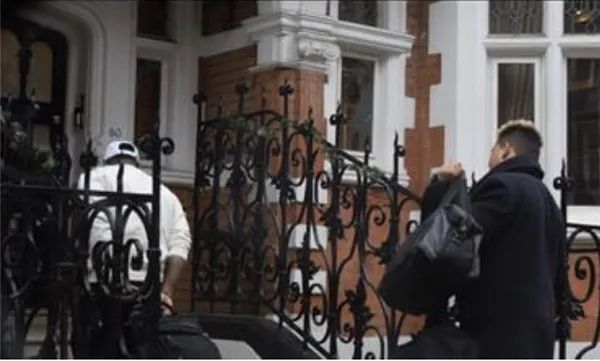

Various Damages Caused by Arkham to the IC Ecosystem
We found that many parties involved in the cases believed Arkham's claims simply because The New York Times endorsed them, and then directly took actions to attack the IC ecosystem, exacerbating reputational damage. This extended to class action lawsuits, one of which is shown below:
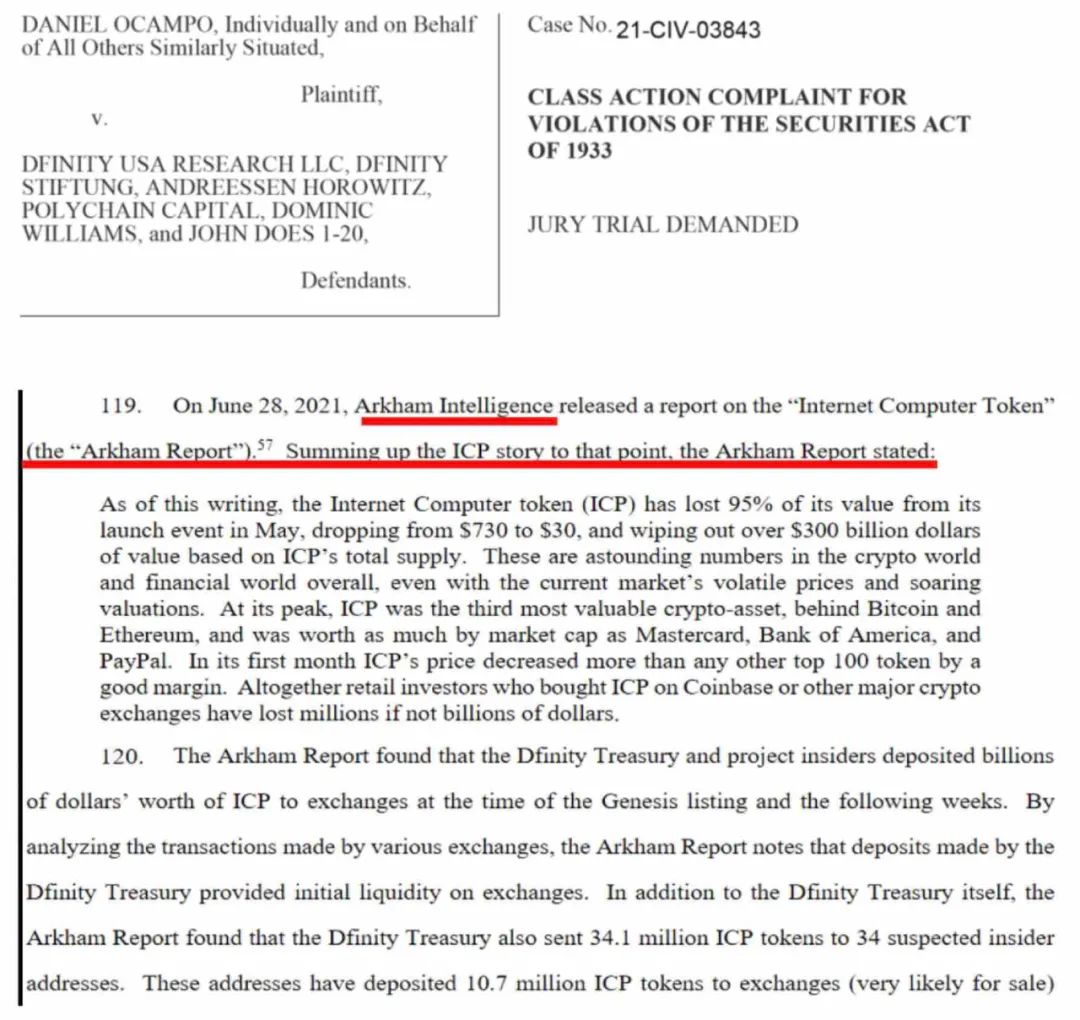
Investigation Summary
As shown by this investigation, The New York Times described Arkham as a respected "cryptocurrency analysis company," greatly misleading cryptocurrency enthusiasts. Arkham not only appears to lack the skills required to write professional reports, but almost every aspect of the organization is highly suspicious. While this investigation has brought conclusive evidence to the world, even a basic, cursory investigation of the organization would show that they are not trustworthy, from the strange misaligned dates on their profiles to the complete lack of any historical records about them or their founders on the internet.
Endorsing Arkham and its report in this manner could potentially reduce the market value of the ICP token by billions of dollars. As we have shown, Arkham may have been paid by competitors or those shorting ICP to create the report, and the company's main investor is also investing in blockchains that are competitors to the IC network. While false statements may please clients and their main investors, the results clearly damaged the reputation of the IC ecosystem and harmed the interests of ICP holders.
Within two weeks of the article's publication, the DFINITY Foundation filed a lawsuit against The New York Times and all team members of Arkham Intelligence in the Southern District Court of New York, with charges of attack and defamation. Ultimately, the DFINITY Foundation won the lawsuit.
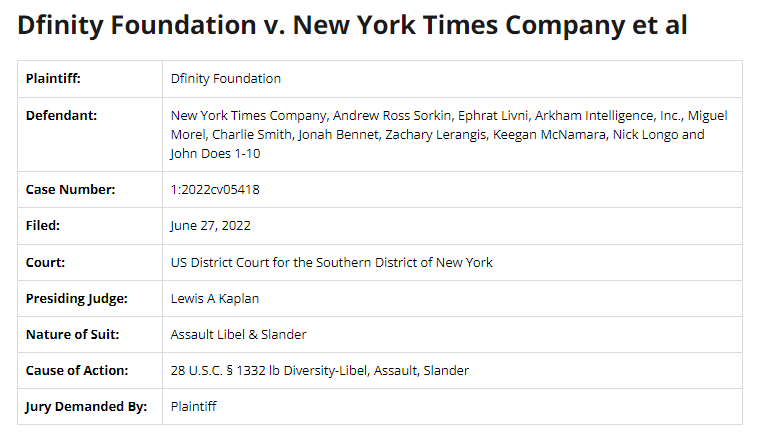
免责声明:本文章仅代表作者个人观点,不代表本平台的立场和观点。本文章仅供信息分享,不构成对任何人的任何投资建议。用户与作者之间的任何争议,与本平台无关。如网页中刊载的文章或图片涉及侵权,请提供相关的权利证明和身份证明发送邮件到support@aicoin.com,本平台相关工作人员将会进行核查。




